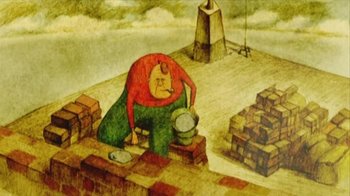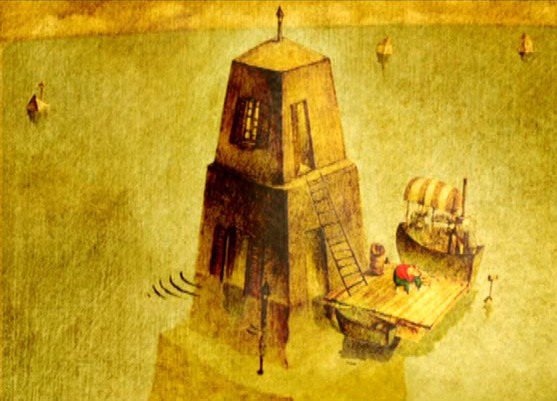A Year in Shorts Day 308: "The House of Small Cubes"
Conventional wisdom dictates that the best part of Pixar’s Up is the first ten minutes, a beautiful opening sequence to which the rest of the movie can never live up. (I disagree with conventional wisdom on this, I think the best part is closer to the end, but that’s beside the point.) And so we are forced to ask- what if there were a film which was like the first scene in Up, and that was the entire movie? Well folks, it turns out that question was answered a whole year before Up was even released, with Kunio Kato’s The House of Small Cubes.
The House of Small Cubes (or Les Maison en Petits Cubes, if you want to use the film's inexplicably French title) is the first Japanese film we've covered in our Year in Shorts, and one of the few Japanese shorts to receive Oscar attention period. Despite its rich film tradition, Japan has actually not done particularly well at the Academy Awards over the years. A list on Wikipedia lists only 59 Japanese nominees in total across all categories (and mind you, that includes Japanese-born nominees who worked on non-Japanese films), with only fourteen total winners. Perhaps even more surprisingly, The House of Small Cubes is the second (and so far, last) piece of Japanese animation to win an Academy Award, the first being Miyazaki's Spirited Away. Considering the culturally dominating force that is Japanese animation, that is really saying something! Although I suppose the most popular anime these days are television shows. Still, as ignorant as I am about anime (and Eastern animation in general) that seems pretty unbelievable. In fact, The House of Small Cubes' Oscar win made history that year when Kunio Kato became the first Asian filmmaker to win the Academy Award for Best Animated Short. And while it seems pretty ridiculous that it took so long for that to happen, at least watching the short itself makes it easy to see why the streak was finally broken.
Told entirely without dialogue, The House of Small Cubes tells the story of a lonely old man living in his house in the middle of a flooded city. Waking up one morning to see that the floodwaters have risen (there's an environmental message here, although it's fairly subtle), the old man decides to expand his house upwards. But when he drops his beloved pipe during the moving process, the old man has to buy himself a scuba suit in order to get it back. As he travels further and further down into the layers of his house, the old man finds himself flooded with memories of the life spent there and the people with whom he shared it. What follows is a beautiful and melancholy reflection on life, love and the passage of time.
The House of Small Cubes combines two of my favorite types of films into one short- movies exploring the nature of time and memory, and movies set in the ocean. (One of these themes is certainly a lot deeper than the other, but my love for them is equal.) And the film more than delivers on both fronts. The flashbacks are all pretty simple, but that's what makes them so lovely. Despite its fantastic setting, this is not a film about plot twists, sudden revelations or earth-shattering moments. It is merely a journey through a life lived, and the beauty in the small, mundane occurrences that life is made of. There is certainly a place for movies about big events (hell, most of the time I prefer them), but there's something to be said about a film finding beauty in the everyday. And when a movie manages to pull it off so elegantly as The House of Small Cubes, well, there's really nothing you can compare it to.
Of course, part of the reason the short manages to work so beautifully is the beautiful animation. While The House of Small Cubes is technically an anime, its aesthetic draws a lot more from Western sources than the typical anime style. (For those of us who aren't particularly fond of the usual anime look, that's certainly a nice bonus.) There's a surprisingly limited amount of information on this short available online, so I can't say for sure what the style is (I'm pretty sure it's watercolors, at the very least), but it's lovely all the same. There's a touch of Michael Dudok de Wit in this film, both with the simplistic but express character designs as well as the deliberate, melancholy pace, and it wouldn't surprise me if Kato listed him as an influence. But at the same time, I do think the film is also distinctly Japanese in a way that might not be immediately obvious, reminiscent of medieval picture scrolls and other forms of Japanese art. Whatever his influences, Kato synthesizes them perfectly, making a film that is both universally appealing and specifically itself. Special mention must also be made of the short's use of color, which cleanly and effectively uses shades of yellow and blue to differentiate the passage of time, similar to what Greta Gerwig would go on to do in a totally easy to follow and not at all confusing as long as you're paying attention sort of way with Little Women. It's a simple technique, for sure, but sometimes simplicity is key, especially when you're tugging at the old heartstrings.
And that simplicity is really what lies at the heart of this short's success. While it's important (and fun!) to celebrate the shorts which try new and exciting techniques, push the medium forward in bold and innovative ways, or are just excuses for the artists to show off their skills, at the end of the day, nothing is better than a simple story told well. The House of Small Cubes may not be as immediately flashy or impressive as other shorts we've covered, but it's a much richer viewing experience than most. Kato and his team of animators do more with simple drawings and subtle movements than many animators (hell, most filmmakers period) could even dream of, aided in no small part by the beautiful score by Kenji Kondo. It's shorts like this that serve as a testament to my belief that animation really is the purest form of cinema. While animation may not always get the respect it deserves, both from the Academy and the public at large, I really don't see how anyone could bring themselves to look down at this film. It is the work of a small group of talented and imaginative artists working at their absolute best, expertly practicing their craft in service of a story. To me, that, more than anything, is cinema.
Is The House of Small Cubes my favorite short? Well, when I planned out our Year in Shorts it certainly was, which explains why I chose to schedule my post on it for my actual birthday. But as the film teaches us, change has a way of changing things, and I think The Man Who Planted Trees has ousted it from the top spot, at least for now. But that hardly matters, does it? At this point, selecting a favorite mostly comes down to little details. In any case, watching The House of Small Cubes has made me realize how glad I am I decided to embark on this Year in Shorts. It hasn't always been easy, but I'm grateful to have the opportunity to celebrate films like this, which don't always get the due they deserve. Those who write off the short categories do so at their own peril; they often contain as much wonder, pathos, humor and heart as any of the features do. And perhaps more impressively, the only do it in a fraction of the time.
Keep up with the Oscar Baiting here on Letterboxd!
The Great Oscar Baiter is a not-for-profit work of criticism. All images herein are property of their respective owners and are protected under Fair Use.




-screenshot.jpg)
Comments
Post a Comment